Futurist Panel
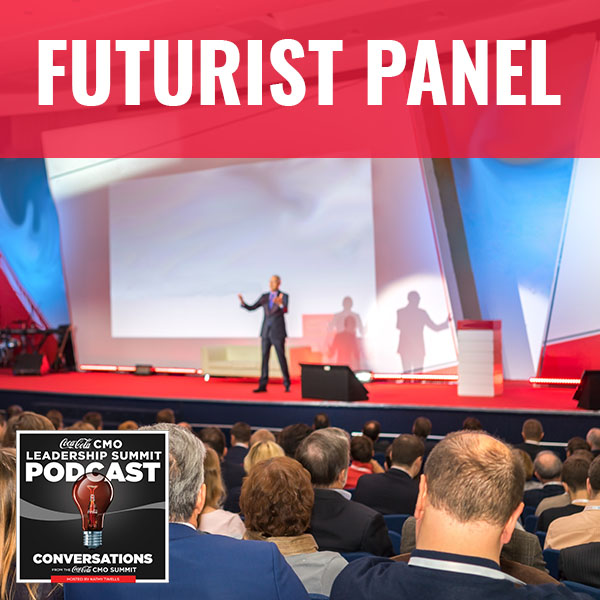
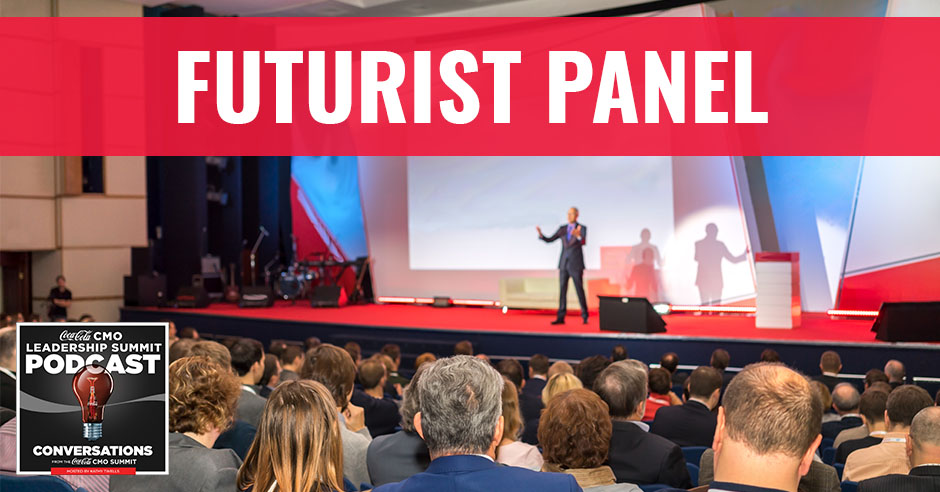
We’re all about uncertainty. This place is one big great what if. Every day, people are placing bets on people who are trying to create a revolution, but we really don’t know how things are going to play out. We need to understand what technologies and fads are going to make an impact and how businesses use the technologies that are under development. So often, the things that we try fail and we have to understand whether they failed because it was something we didn’t do right, whether it’s because the product or the technology was ahead of its time, or whether it just didn’t really fit. There needs to be change because ultimately what we want to do is to create change in business and in society. That is what the futurist panel is going to be exploring.
—
Listen to the podcast here:
Futurist Panel
This is the full discussion of the Futurist Panel exploring the new world from the 2017 Coca-Cola CMO Summit.
We are about uncertainty. This place is one big great what if. Every day people on the panel here and elsewhere are placing bets on people who are trying to create a revolution, but we really don’t know how things are going to play out. Secondly, it’s about understanding. It’s about understanding what technologies really are going to make an impact, what are fads, understanding how businesses will use the technologies that are under development. Third, it’s about rebound. Often the things that we try, the entrepreneurs we back fail and we have to understand whether they failed because there’s something we didn’t do right to help them, whether it’s because the product or the technology was ahead of its time, or whether it just didn’t really fit? That’s the question we always ask ourselves. Finally, it’s about change because ultimately what we want to do is to create change in business, in society, and that is what this panel is going to be exploring. We’re going to try to make it as applied to your jobs as possible.
There’ll be big picture themes and then we’re going to drive down to what that means for you as chief marketing officers and as leaders in your businesses. I’m going to introduce my panelists. At the far end, I have Greg LaBlanc who is a professor at UC Berkeley. He is a master of many things, law, economics and technology, and he will talk to us about his experiences of working with lots of different companies as well as what he teaches. I have Rachel Chalmers, who is a technical consultant at Merian Ventures, which is a new venture capital fund just being formed. Rachel has a fascinating background, you can see that in your bio there. She’s going to talk about her personal experiences of backing companies.
We have John Livesay who is the author and a startup whisperer. He whispers to start ups and makes them incredibly successful. We have Joanne Chen. She’s a partner at Foundation Capital, which is a leading early stage investment company and invested in a number of very successful firms, which I’m sure she’ll mention as we work through. I’d like to pick a particular technology. Each one of you pick a particular technology that you think is going to be transformative over the next five to ten years. Explain why and what it means for our audience. John, do you want to start whispering?
Artificial Intelligence is here to stay
Artificial intelligence is definitely something that is here to stay, it’s not a fad. When I worked with a startup called Fido Labs, which is competing against IBM Watson, I was working with them on their pitch to get funding. He started talking about, “It’s structured data and unstructured data.” I said, “Nobody should have to be an artificial intelligence expert to understand what you’re saying, let’s come up with a story, an analogy.” We used on the pitch deck an image of an iceberg and above the iceberg was the structured data and below was the unstructured data. I said, “What is the difference between what you do and what IBM Watson is doing?” That’s really a key factor in any marketing that you’re doing, what’s your point of difference.
He said, “We understand verbs and IBM Watson doesn’t.” I said, “Now, we need a story to go with that.” You come home, you see your wife crying, you don’t know if it’s tears of joy or tears of sadness because you left your socks on the floor again and she’s so frustrated. Once you know why she’s sad, then you can take the appropriate action. The same thing is true for the brands that are going to use your artificial intelligence, if they know that something’s trending positively or negatively on social media, but they don’t know why, they can’t really fix it. Once we know why, then he was able to get the funding he needed. Artificial intelligence is a tool to better understand your customer.
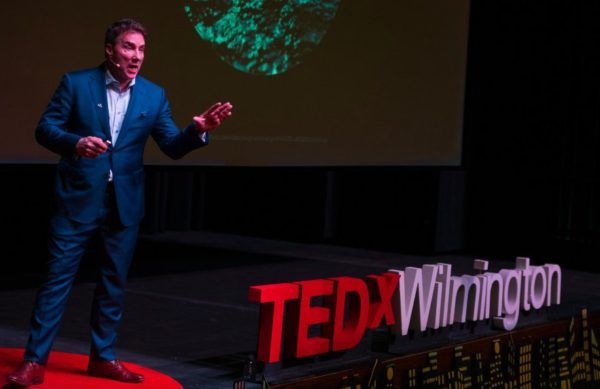
Futurist Panel: Artificial intelligence is a tool to better understand your customer.
Joanne, you made some investments around artificial intelligence. How do you see it? What’s the vision for this new technology?
It will be helpful for me to try to explain what that means from a technical perspective in a very simple way and then give you a couple of examples of how we think about it. I’ll start with comparing and contrasting what computers could do before and what computers could do now with artificial intelligence to try to explain what’s possible. This concept has been talked about since the 1950s, the notion that computers can think like a human and make decisions. We’ve seen it in science fiction, we’ve seen the movies. However, there are massive limitations. Before artificial intelligence was usable, computers can do very simple things, like follow rules. To give you an example, this is called Functional Programming. If I want to determine someone’s age, I can tell the computer the formula for determining age is to use today’s date minus their birthday. That is a very straightforward formula. The computer will get it right 100% of the time. That’s called Functional Programming, that’s what we used to do with computer programs.
Machine Learning has been talked about for actually quite some time as well. To give you an example of what machine learning can do, the computer using machine learning can probabilistically determine someone’s age using a data set. As an example, I can give the machine a thousand data sets that have people’s ages. There are some preferences as two variables. If you think about it, people who are 25 may prefer Selena Gomez, people who are in their 60s may prefer some other artists. I can ask the machine, “This person loves Celine Dion, can you tell me what you think that person’s age is?” The computer can use that data set and think, “They’re probably 35, 40.”
Deep Learning
What’s changed is really the scale of the data sets that are available, the scale of the computing power, and the scale of the applications that all this new technology can be delivered into?
The thing that’s been talked about mostly in the media and the last two or three years is the notion of Deep Learning, which is a new way that the computers are learning, which is by example. Just like a child where they’re seeing examples of real world. For example, if a three-year-old child sees a cat a thousand times by the time they’re three years old, now, they can recognize a cat because they’ve seen that examples over and over again, and because of what you said, advancements in computational power, in algorithms, in data sets, the computers are starting to be able to do that just like a human could.
Think About Management
Greg, pick a big technology that you think is going to be transformative.
To pivot the conversation just a little bit away from what we normally think of as technology, such things as Blockchain, artificial intelligence, Internet of Things, Connectivity and so forth, think about management. Management is an area where technology changes very dramatically. We look at the major differences in the standard of living between say the Soviet Union and the U.S. back in the 1970s, it wasn’t because of differential access to technology. If we look right now at the difference in the standard of living between India and the United States, it’s also not about differential access to technology. If you look at the difference between a successful company like Tesla that’s growing and maybe a company that is finding it a little bit more difficult to grow and develop a like a Ford, the difference is not access to technology as we normally think of it.
The main difference is in what I might call managerial technology or organizational technology. All of the great technological developments from the steam engine to the railroad to the telegraph to the computer, the only way that they were actually monetized and the only way they’re able to impact our lives is by a change in the way firms operate, in the way in which they manage their people. I think we’re seeing probably the most fundamental transformation in management happening right now in human history and the way firms like Amazon and Facebook operate would be completely unrecognizable to the managers of the 1950s or even the managers of the 1990s.
Intersection of Culture and Technology
Management is technology. Rachel?
I’ve been thinking along very similar lines to Greg for quite different reasons. I’m a reconstructed ‘90s tech idealist who’s dismayed by what’s happened to the tools that we built. Pierre Omidyar had a good op-ed in the Washington Post, Six Reasons Why Social Media Is Now A Threat To A Democracy. I’ve been thinking a lot about the intersection of culture and technology, which is not as distinct domains as a lot of people think. In terms of the fact that the ability to fail faster is already here, it’s just not evenly distributed yet, to rip off a William Gibson quote. It’s encouraged to fail fast if you’re an engineer or a white man. I’m interested in extending that grace of technology to other groups and other functions within the organization.

Futurist Panel: I’ve been thinking a lot about the intersection of culture and technology, which is not as distinct domains as a lot of people think.
Some of the specific technologies I’m really interested in are Slack, which empowers collaboration on a scale we’ve never seen before. A tool called Honeycomb, which is a Slack-like tool for collaborative debugging of engineers across very large distributed systems. A tool called LaunchDarkly, which is particularly relevant to marketers because it lets you flag specific features in a product or site. If those experimental features don’t work, you can take them down very quickly without taking down the whole site. It’s a way for sites themselves and experiments to fail gracefully. A technology that pulls all of these together is Jesse Robbins who was an infra engineer out of Amazon who is also first responder. He has put together a company called Onyx to build essentially a Star Trek communicator, which is ideal for use by emergency responders in situations like Puerto Rico where the phones are down.
As moderator, I’ll add one. Automation for us is so critical. We see robotics reaching a point where there’s a takeoff factor coming now. For a long while, we’ve been playing with robots and general automation. What I mean by that is taking in everything from autonomous vehicles right down to the robotic arm that’s it’s in a mall here that serves coffee. It’s still really early in this evolution, these coffee machines called Café X. It actually has three human beings standing around serving the arm in case it goes crazy, but there are lines of people queuing up to try that experience.
We’re trying to experiment. There’s another company called Chowbotics. There was an article in New York Times about Sally, which is an automated salad maker. Whether this was going to put out tons of people out of a job, but Sally actually is very convenient, it’s very quick. It can do lots of different things compared to where we were even three or four years ago. I think the whole automation training is going to be big. Another one which I think Joanne was going to talk about is VREM.
Virtual Reality
I think virtual reality is going to be a dominant content format in the next ten years. I say this because we were early investors in Netflix which kicked off this whole streaming on-demand revolution. The difference between viewing television before versus what Netflix delivers in experience with the consumer was ten times better. The delta between what Netflix can deliver and what a good virtual reality experience can deliver over time, I think we’ll be 100 times better. I believe this so much that personally, when I got married a couple of years ago, I worked with a VR studio to produce my wedding in VR. The reason I did this is because I think that my kids and my grandkids will only see that as a viewable content format. Actually, the funny thing is a part of the reason I did this is because I have a grandfather who was a 102-years old. He lives in China and he was not able to join us and this enabled him to experience that.
To work with Gensler, which is the world’s largest architecture firm, they now bring Virtual Reality goggles when they make a pitch, so they can experience the design and not just look at the blueprints. I was talking to Claire from Schlotzsky. We were talking about when you’re creating a new brand like that, how do you get people to stay engaged if they’re coming to watch sports? If this game’s not interesting, people leave and don’t buy as much Coca-Cola and drink and eat as much as you want them to or sandwiches. When virtual reality and augmented reality get integrated into the experience there, then they can start betting with each other and having their own pools. The technology can help what you’re doing in the food and beverage world.
It’s interesting you mentioned Augmented Reality because from my perspective, I’m actually skeptical about how quickly VR is really going to take off. There’s just so much underlying technical advanced that’s needed, whereas Augmented Reality, it’s here. This Apple announcement, very clear, Google was there before. You do see the Game of Thrones of large tech companies. If you want to see things that really are going to advance, watch where they play. When they come into the same market together at just about the same time, it’s going to be significant and it’s just easier on a platform. Rachel, you were going to say something?
Yes, I was going to say Ingress and Pokémon GO are really fantastic examples of Augmented Reality that’s already here. Virtual Reality has a longer history than we appreciate. A lot of the companies that I just mentioned, I’m a part of a generation of really extraordinary women engineers who came out of Second Life, Linden Lab was a really extraordinary engine.

Futurist Panel: The difference between viewing television before versus what Netflix delivers in experience with the consumer was ten times better.
There are all these technologies. If I’m a Chief Marketing Officer and I’m trying to work out which ones are really serious and which ones are fads, how do I decide? You have a wonderful term for what we do as venture capitalist.
We’re toolmakers. Silicon Valley Hype merchants have their eye on your marketing budgets, we all have large portfolios of marketing automation and we would like to sell you cherry pickers. Maybe the problem is that you’re trying to solve a plumbing problem. The challenge for marketers is that you do have this budget, you do have a lot of very motivated, very greedy investors trying to offload and possibly devalued property onto you at inflated prices. The way I like to encourage people to think about it is that you don’t need a tool unless you have a problem that you’re trying to solve.
Manage your data
Until you understand the dimensions of the problem that you’re trying to solve, you don’t understand the dimensions of the tool. You need big data, which I love big data as an industry. I was very close to the founders of Cloudera, which was an extraordinary company. There’s a lot of Hadoop out in marketing departments being grotesquely underused because they were bought by people who didn’t understand how to use them and didn’t have a real need for them. It’s only when you have a really clear idea of what you’re going to do with a particular technology that you can come up with a use case for it and inappropriate budget.
I think that the biggest transformation and managerial decision making is all about the early arrival of information. Historically, managers would have to make some forecasts or predictions about the future world to make a decision. Then they’d sit back and wait for information to tell them whether they were right or wrong. What has made management so different now is that we can pull that information into the present, we can accelerate the arrival of that information, thereby making better decisions. What lies at the heart of that is experimentation. It’s the ability to run controlled experiments that help you to get answers to your questions much earlier. What this does is it massively dramatically reduces your expenses related to the achievement of an objective because you know what works and what doesn’t work. If we think about something like VR/AR, I know a lot of people think of it as a media play and think of it as an entertainment venue.
If you’re a marketer, you should be thinking about this as how can I use these tools to get information more quickly. Instead of asking people what they intend or asking them what they might want to do, put them in experiences where they can reveal what they would actually do so that you had that information earlier before you have to make major investments.
It’s an excellent point and it comes back to what you were saying, Martin, about automation. There’s always been this idea that automation puts people out of jobs and it’s true in certain circumstances. In other circumstances, the right automation makes people much better at their jobs. Software is just distilled best practices. It’s just our best understanding of how to solve a set of problems automated. When you have effective marketing automation, for example, that automates 80% of the boring chores that make up your job, that frees you to spend all of your time on the 20% of your job that’s actually interesting and creative, which is asking the right questions.
I just want to add the concept of having all this data that you can then use as a chief marketing officer allows you to change your behavior that the previous speaker was talking about. Instead of fearing failure so much because so much was at stake before, now it’s not an all or nothing. I’m not going to lose my job if I make a decision and it doesn’t work out because I haven’t had to spend as much money as I used to figure out if this was the right decision. Once we dial down our internal fear of failure by having these new tools, then the whole culture changes where we start embracing it and looking at it as just feedback and not a personal reflection of our own worth.
This is the decade of the CMO
Adding to this, I think as investors we’ve been incredibly bullish on the opportunities serving the CMO. We think that this is the decade of the CMO as CMO’s role transitions from a call center to a revenue generator. We’ve done incredibly well investing in the space, looking at Netflix as well, the early companies that use marketing technologies in house before this was even a category. The way that we think about investing companies falls under three buckets broadly. One is the notion of automation. What are the things we’re doing that you may not want to do that a machine can do for you? Companies like Custora, which enables retailers to build segments to target their audiences. Marketers spent a couple of hours doing this to already do this very easily. Another example is what are the shifts in consumer behavior that the marketers want to tap into? This is a little bit riskier but has higher upside for us because customer behavior may or may not eventualize.
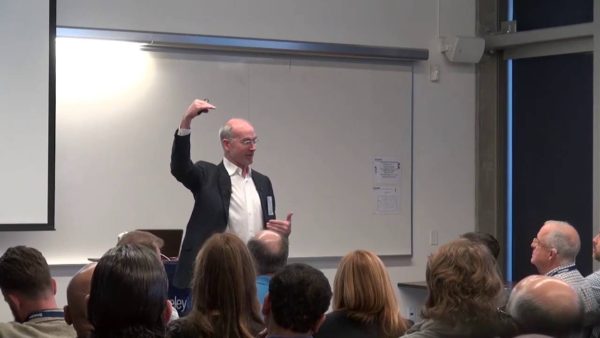
Futurist Panel: Management is an area where technology changes very dramatically.
This includes companies like one that I haven’t yet announced, but looks at conversations and messaging as a primary interface of customer behavior. I spent a lot of time in China and it was very obvious even five or six years ago that customers want to message. The third, I think is the labor force optimization which this is some of your most priced resources that you have. Our company Next Force actually works with franchises in the restaurant space to think about how do you optimize labor to make that cost goes down.
Think like a VC
One comment on that, I would encourage you to think like a VC, put us out of business. What I’m trying to say there is number one, it was great comment about getting the eggs to teach the chickens. That’s one of the things we really want to do very aggressively. We go out and we try to find early adopters, young people who are changing behavior. Technology does change behavior, but people change technology. It’s really important to understand what’s going on at the bottom. Second phase, your investments, look at how VCs work. We make lots of little bets ,smaller bets, and then we gradually ramp them up.
If you want some early indicators of what’s really getting traction, look at B and C funding rounds across the elite venture capital companies of which of course the three represented on this panel are part. Look at what’s going on there, there are public databases available. You would see two years ago, three years ago, investment in VR and AR is really starting to trend aggressively. That will give you an indicator. We’re not always right. Probably a decade ago, investment trended in green tech and billions of dollars were lost by some very smart VCs. Bear in mind we’re not perfect, but nevertheless, that’s a really an interesting indicator. There are various ways and mindsets that you can bring into your business that Silicon Valley has helped to create. I want to just break through some questions because you guys are very smart people and we’ve covered a lot of great ground here.
We’ve worked with a lot of small startups and a lot of them are brilliant and they bring great innovation and great ideas. I think your point around managerial change and organizational change can’t be stressed enough. Larger organizations, we’re not nimble enough to even embrace some of these technologies that we as marketers, we know that we need to embrace. The organization just doesn’t have the tolerance for the structure or even the whereabouts to know where to start. I would encourage, I don’t know if it’s a question or just a thought that as VCs, if you could start to partner or maybe better understand the changes that need to occur in these large organizations, that would be huge value add as we start to look at these indicators and really integrate them into our organizations. Otherwise, they just play nice out here, but the real truth is there’s no true integration and then you’d never get past step one.
The best practice I’ve seen here is Skunk Works, some of the Fortune 100 have these fabulous little groups typically located in Silicon Valley, often associated with strategic venture, sometimes not. Coca-Cola ran one of these, Danaher was another, Bechtel had a very good group. These would operate as much like Leonard Brody described in his talk, the way Match.com developed Tinder, you can do that. You can develop an immune system within your organization by locating some of your brightest engineers in Silicon Valley and incenting them to behave like a startup whose job is to put the mother ship out of business.
Avoid idea constipation
One exercise you could go through is at every single note of your organization, look to see how the following process works, how are ideas generated, how are they evaluated, and how are they executed. I think what happens with a lot of organizations is they get idea constipation. The execution never happens. People say, “Why even bother to evaluate the ideas if they’re not going to happen?” If people know that the ideas are going to be evaluated, then they stop generating them and injecting them into any system. If you go through and look at every single point in the organization, if you went to every individual and said, “When you have an idea about how to improve things, where do you go?”
If the answer is dead end, nowhere to go, then you know that organization needs to change things. That means that everybody from the top down has to think like a VC. Everybody from the top down has to be willing to say, “Let me hear this idea, what is the least amount of resources that you need in order to get to the next step to find out if this idea is any better?”If that idea, that mindset of thinking like a VC at the decision level goes from top to bottom, that’s the only way the organizations can start to move a bit more agile. It may require that you remove people to different locations but then the feedback becomes a challenge.
I think Facebook and Google do this better than VCs. VCs are very prone to the Sunk Cost Fallacy. Flat organizations like Facebook and Google, which have figured out how to maintain high levels of innovation even with very large organizations, are very unhesitatingly willing to cull projects that are not producing results.
Other questions for the panel?
I can contribute another perspective. When I worked at Condé Nast, they tasked me in the corporate division of finding technology that could help solve problems. I think if you use that filter of what’s the problem we’re trying to solve here versus what’s all the technology that’s so overwhelming and what’s the one technology we can use. In the case of Condé Nast and the analogy that we heard of the hospitals looking to the cars to fix. If you look at what Condé Nast is trying to solve and maybe that applies to what you’re doing, their problem was nobody was clicking on a static banner ad and they were at risk of losing millions of dollars of digital advertising that wasn’t giving an ROI. It was my job to find a technology, a startup that could solve that problem.
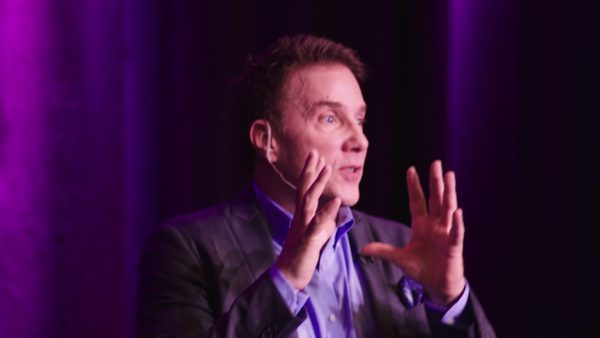
Futurist Panel: Use that filter of what’s the problem we’re trying to solve here versus what’s all the technology that’s so overwhelming and what’s the one technology we can use.
Have a filter and a lens
I had a filter and a lens. Someone in your team, if you or someone else has a specific problem and then you start looking for the technology that could solve that, I found a startup that had a shoppable video player that could be overlaid a rich video ad as opposed to a static banner ad and people could shop right from the video that would then give an ROI. That is how we used the new startups to solve a problem that we had corporately that we couldn’t figure out.
The biggest enemy of a new idea is another new idea. I wish the word “pivot” had never been invented because entrepreneurs coming out, “I want to pivot this way, now I want to pivot that way.” It’s like a wind vane, they move around. One of our biggest jobs is to keep them focused on what they’re trying to do until we really understand whether that idea is a good one or a bad one on. I would encourage you in your businesses, try not to do too many things, drive down, focus on a few, and then really if the employee or the team starts to say, “We should go over here, we should go over there,” really examine before you let that happen, because a lot of ideas die simply because they’re just not really pursued deeply enough.
You remind me one of the investors I interviewed, he said, “Don’t try to boil the ocean.” If you can say that your team, “It looks like we’re boiling the ocean here, let’s get back to focusing on one thing.”
I want to switch to my favorite tech futurist, Charles Dickens. He wrote A Tale of Two Cities. It’s actually A Tale of Two Valleys right now. In A Tale of Two Cities, he said, “, it’s the best of times, it was the worst of times.” Right now, in Silicon Valley, we are in the best of times. This is an incredible innovation boom. We’re seeing billion-dollar, multibillion dollar plus companies created. At the same time, we are seeing a backlash against technology, the likes of which this place has not really ever seen. I’d like to explore with the panel where we’re talking about future technologies, how do we deal with this good tech, bad tech rap that we’re getting. For companies actively using technology as well. If you drive automation, you drive bottom line, but at the same time you’re destroying jobs. What does that mean for a brand? What does that mean for how you think about how you organize your business?
Human factors are critical
I’d like to follow up on Rachel’s point that we used to talk about the Satanic Mills back in the 19th Century about the factories. We started bemoaning when all of these factories started shutting down and people started moving into the office. Then we’ve bemoaned the drudgery in the office and the meaninglessness of paper shuffling. Now that those jobs are going away, everybody’s bemoaning the loss of those jobs. I think we’ve seen a chronic continual increase in the quality of our life and yet a constant thermodynamic rule applies to the level of disgruntlement that we all experience. I think that the human factors are critical.
Jack Levis, who is the COO of UPS, when they introduced Orion, which is our software that automates delivery routing, they spent billions of dollars on this. You go to somebody who has basically invested their entire life in developing some human skills around delivering packages. Then you come in and say, “Just follow orders and do what the algorithm tells you.” He said that the $3 billion developing the software, it was nothing compared to convincing people to adopt it. He said, “There’s only a couple of things you need to do. One is make that people still believe that they have value so that they value and they can override or inject information into this. They can supplement the software rather than being replaced by it. Number two is if you give them enough freedom to express their individual opinions about things, it doesn’t have to be 100%, it can be 5%, and that 5% is enough to get adoption.” I think we really need to think about the human elements, human factors around adoption of technology.
My favorite tech futurist is Mary Shelley, who invented science fiction with Frankenstein. We have certainly created our own Frankenstein’s in the tech industry, we have created monsters. The interesting point that Mary Shelley made was that the monster was not monstrous inherently by virtue of its creation, it became monsters because of how it was treated. Algorithms are not morally neutral. When we create software that treats people badly by design, we create terrible companies and terrible outcomes.
I’m fairly optimistic about all this. The reason why I say that is because while I do believe automation starting at the lowest level all the way to software engineers and people who are considered skilled will eventually be replaced by machines. There are pieces that are incredibly important that will never go away, and that’s part of human relationships. The heart in every single solution that companies deliver, that needs to be managed by humans. I think service will become an incredibly important part of our future in terms of jobs, in terms of opportunities. Customers will care more and more about the experience that they’re getting, which is great news for CMOs.
A good example of that is Nike. Whenever you can deliver something customized for people, they are emotionally engaged, they become brand ambassadors, and become loyal. Nike allows you to either go into some of their stores or online and customize your shoe laces and what you want your shoe to say. The more that technology gives people the ability to customize something, then they welcome it.
The heart in every single solution that companies deliver needs to be managed by humans. Share on XIn terms of how we go forward from here, is it a branding issue, a marketing issue? One of these startups we work with the stopped talking about artificial intelligence and talks about Augmented Intelligence. We’re saying we’re augmenting the human so it needs a good CMO. It’s about trying positioning and their would be, “It’s true.” We may see some jobs removed, but actually the remaining jobs are going to be far more satisfactory because what we’re doing is we’re taking away the drudgery.
This one actually it’s about monitoring service. Right now, an individual in an IT team can monitor about thousand servers using Artificial Intelligence, Machine Learning. It can be 10,000 servers. You need a fraction of the people, but the people who are left can go do a lot more because the machine is taking off a lot of the work from them. It’s like you’re in the Satanic Mill, you’re coming out. It’s a branding marketing problem, but Silicon Valley really needs some help on it.
Promote the concept of comparative advantage
There’s a concept in economics called comparative advantage. When a lot of people think that China’s going to manufacture everything and then we’re not going to have anything to do and we’re all going to be out of work. The only way they can export stuff to us is if we send something over there. Similarly, when we look at automation or human versus machine, it’s not about absolute advantage but about comparative advantage. There are things that machines can comparatively do better than humans and things that humans can comparatively do better than the machine. If I’m a doctor, I don’t have to spend all my time doing paperwork and looking at MRIs. I can actually spend more time talking to the patient and doing the things that only humans can do. As people who support the advance of technology, we really need to promote that concept of the comparative advantage of the human. Perhaps education should focus more on those human things and less on the stem, which is counterintuitive.

Futurist Panel: The only way they’re able to impact our lives is by a change in the way firms operate, in the way in which they manage their people.
Look at the media landscape for at least the channel of getting communication to customers. We’ve seen, because of technology, an incredible explosion of channels, everything from blogs to new kinds of video media outlets. Getting the message across seems to be much, much harder. How do you think that landscape is going to evolve over the next three to five years and what technologies are coming that are going to change there?
I think historically in marketing type, we’ve looked at investments per channel very aggressively. Companies like TubeMogul, which is the programmatic advertising platform video, which a lot of marketers use to do video advertising. Localytics, which is a mobile analytics engagement company. We’ve thought about marketing on a channel per channel basis because the constituents, the decisions, the budgets are aligned nicely that way. The shift I’m seeing is that there is more and more interest on companies that span across functions, tying marketing, sales, customer support, customer service, finance. Some examples of that, the whole idea of conversational AI solutions can do that because there’s one interface with the customer. The voice-enabled technologies that we talked about have the same potential. Right now, our shift is, how do we think about holistic customer experience versus a channel driven solution that automates?
Coming from Los Angeles and being involved in the television industry. Certainly, the major networks are being disrupted. Along comes HBO and then they start winning the Emmys, then they just think they on top, then along comes Netflix and Amazon and they start winning the Emmys, and the most recent Emmys, HULU beat them. Just when you think you’re at the top and you can rest a little bit, you can’t, because there’s always somebody else nipping at your heels. What the main networks are trying to do is reboot. “Let’s bring back Will and Grace.” That’s what NBC is doing. ABC said, “Let’s bring back Roseanne.”
One’s very successful and had a tremendous amount of buzz because they tested it, not intentionally. They thought Will and Grace was done, they did a short little video during the political campaign and saw that that little video went viral. They knew there was a reason that people would want to watch Will and Grace and the chemistry is still there. Somebody at ABC just made the decision to bring back Roseanne back with no testing whatsoever while trying to go after millennials. CBS on the other hand is saying, “We’re going to create our own app and see if we can get people to pay. We’re going to run show on CBS as to get exposure and then have people pay to watch the remaining episodes, The Good Wife sequel, the new Star Trek, and see if we can get our own version of paid streaming. People continue to try and innovate to solve this big problem. I think that’s a great example of disruption and trying to figure out how to continue to reach new people in ways and new structures.
We talk about a fragmented marketplace, but when you look at digital advertising, it’s game of two. They are two totally paranoid, totally aggressive players, and have done a remarkable job of protecting their turf. I’m talking about Google and Facebook. Is that going to last? Are the network effects going to last? Are there technologies that are coming along, perhaps a VR or an AR, but they don’t actually own that could create some new movement, a new marketing channel for a company.
Advertisers want integrated advertising
With my advertising background, I can tell you what the advertisers want is integrated advertising. No longer interrupting people with commercials or an ad in a magazine, but they want to be integrated into the story. You as the CMO, the more you can integrate into someone’s life, that’s why earned impressions are so important. You’re not paying for those impressions, somebody becomes your brand ambassador and shares the content. You see the networks trying to use our Augmented Reality where you can put popcorn into your mouth on your Facebook and pretend you’re watching the show. There’s a new show called The Good Doctor. He’s autistic and he can supposedly see your skeleton when he looks at you. There’s an Augmented Reality app now on Facebook that ABC put out to promote that show. You can see your own face with a skeleton.
People continue to try and innovate and figure out how to continue to reach new people in ways and new structures. Share on XTo push this, is that enough to disrupt? Google and Facebook have incredibly powerful network effects. I think Leonard put up the chart that showed the half-life of every Fortune 500 companies. Are we going to see these guys disappear? Is there some technology out there that we can come up with? We would love nothing better than to disrupt them, but do you see anything?
I think that Google and Facebook are incredibly good at distribution. If you look at what they’re trying to do, they’re trying to move more and more into content. Content that engages the end consumer. I believe that eventually content that is interesting, engaging, and captures a lot of audience will win and create a different distribution platform. If you look at most of the social media players, that evolution is very clear. First audience, then how do you get creators come onboard like YouTube? You can look at Musical.ly, which is a company that is targeting the teenage demographic. What they’ve done is creating a video super easy in a couple minutes because the eventual asset is content.
Any other questions from the audience about some of the things we’ve covered?
I would like to just know if you have any advice for the retail industry. The retail industry as you know operate on very slim margins and there are a lot of things that are disrupting the category and it’s forcing us to be innovative, I think for the first time truly.
Is there any advice for the retail industry which is being disrupted dramatically and operates on relatively slim margins? What can we do help the retailers?
Increasingly we talked about Google and Facebook. The only competitive advantage that you have now is access to proprietary information, access to proprietary data. Obviously, there’s brand and obviously, there are other kinds of barriers to entry, but really it’s about proprietary information. If you have direct interface with customers, then you have the opportunity to acquire unique proprietary information that only you have access to.
The big problem for instance in marketing is that you’ve got Google and Facebook standing between you and your customer. As a retailer, you have all sorts of other opportunities to engage with your customer that cannot be replicated by others, that cannot be observed by others unless you allow them to observe it. I think that retailers really need to focus on what information can they access that no one else can access and then how can they leverage that to create an experience or to create a product that the customer wants.
Geo-targeting with mobile
One of the things that retailers are really starting to embrace this geo-targeting with mobile. If someone’s within so many miles or walking in a shopping center, they get a push message on their phone to come in with a coupon or once they enter your store, the staff is alerted that this is a regular customer and maybe even remembers their order. That personalization is a great use of technology to separate and differentiate yourself so that people feel loyal.
We’ve invested in startups that served the retail industry. A number of them, Custora as one example, QuanticMind, and a bunch of others. I think the biggest challenge when I think about their path to getting customers is that the customers have aspirations in terms of where they want to be but don’t have a good understanding of where they are in terms of what’s possible from an infrastructure perspective. I think the first is just to ask yourself, “What do I have and what is the lowest hanging fruit I could improve on?” Once there is a base where data is accessible, data is structured in some interesting format, then think about what is the company that can partner with you to drive results. I will think about the whole entire MarTech stack holistically in terms of how that aligns with your goals versus look at individual players and point solutions in terms of working with vendors as well.
What I would say is I think really differently. Don’t look in the retail industry and other retailers, look at entertainment. I went into a Lowe’s store where they have these virtual headsets, which you can imagine what your kitchen would look like once you put the Lowe’s appliances. It’s not what I expected from a retailer. They’ve put a pirate ship store and they use that as a Guinea pig and they ran it there. It was very successful and now they’re rolling it out to the whole Lowe’s chain.
It’s trying to think about what that next generation of consumer wants and I still count myself even though I am relatively hairless and relatively old as the next generation consumer because I live in the future. My goal is to think about what’s coming way beyond now. That to me is make the retail store an entertainment experience. If you do that, think about it through the lens of the instrument, go talk to others. That’s the best thing that you can do. We’ve made investments in the retail industry, it’s difficult, the margins are very slim. Doing real innovation in terms of big investments is hard, but I think there’s a lot you can do lean experimentation looking at others.
Look for counterintuitive leading indicators
There are some counterintuitive leading indicators as well. Bookstores were probably the first to be completely disrupted by Amazon. Bookstores are making a comeback. People are starting to open them again. The difference is that these are bookstores that are focused on experiences, on getting bestselling authors in to sign for them. Even things like the shelf talkers, the handwritten notes, the bookstore proprietors have that recommend specific books. Vinyl would be another example. I have a fourteen-year-old, she’s got a turntable, we have to go to the record store in every city that we go to. In the UK, manufacturers that press vinyl are now pressing more vinyl than they did in the mid-2000s. It’s not all doom and gloom. Stores that deliver an experience to customers, create a loyalty that is an inaccessible to Amazon, that’s exactly why Amazon has bought Whole Foods.
Can we site experiences with companies that have done well and retail startups and ones that have failed?
If I use Custora, what they do is they work with retailers and brands by getting together the different data assets that the customer has, providing an intelligence layer and segment of the customers so that these retailers can target their customers more easily. It’s a SaaS-based solution, a company space in New York. I think their best performing customers are ones that have a data infrastructure that is easily accessible. Integrating offline and online with other channels is doable and the company has the resources to be able to help them get to that point. The customers that don’t see success is not at the point of performance, it’s at the point of implementation. Implementation is probably the biggest challenge.
There’s a couple in Marion’s portfolio which I think are interesting. One is Provenance, which uses Blockchain to tag specific batches of organic produce out of the farmers and trace the chain of custody all the way through the supply chain to the retailer. The co-op in the UK is using that technology to assure its customers that this is genuinely organic food and not inauthentic. The other interesting company that came across my desk is actually Straight Outta Y-Combinator. This one’s interesting to me because I paid my way through university as a checkout attendant.
What DukaConnect has done is turned an Android phone with open source image recognition into a device that can scan products that don’t have barcodes. If you’ve been to a Duka in Nigeria or Lagos, they break down big packages into smaller packages that aren’t barcoded or they sell a lot of Chinese produce that doesn’t have barcodes on it. I was holding the phone and it scanned these unbarcoded products exactly as if it were reading a barcode. That’s going to address a huge market, not only in central Africa but also in India when 94% of retail goes through little corner stores like these.
Implementation is probably the biggest challenge. Share on XThere’s a start-up, I can’t remember its name, but it’s basically trying to create the personal shop. They have a location here in Menlo Park. Can they stop shoplifting if there’s nobody in there? People walk in and walk out. Actually, the technology is just really good because it’s censored everywhere, there are cameras in there. Wastage is way down over what a normal store would be. How you feel about that experience with nobody really in there is the question. It’s that different thinking that’s out there that we need to explore more deeply. Is Elon Musk right, is AI going to wipe us all out, so is this all irrelevant?
I think asking that question tells us more about Elon Musk than it does about AI. It is possible to raise a child who grows up to be a serial killer, but there are a lot of things you can do to try and minimize that chance. Artificial intelligence, should they become sentient, are literally going to be our children. To be afraid of them says a lot about who we are as people responsible for other growing lives. The other red flag I wanted to run up is about nano-demographics. They’re not a new technology, East Germany had nano-demographics. It was called Stasi Surveillance. I think a lot of the Ad technology that we’ve built has extremely sinister side effects and that we didn’t think about when we built it back in the ‘90s when we were all idealists. I think this is a moment of time where it’s really incumbent upon us as technologists to take to heart the fact that algorithms aren’t value neutral and to bring our whole selves to work so that when we build tools, we’re building hyperbaric chambers and not gas chambers.
Have a relationship with your customer
I think it’s important to remember that you still have a relationship with your customer. Just because the technology allows you to stalk them with retargeting doesn’t mean you should automatically do that unless they’ve opted in to want to continue to get those messages much like a date. You don’t keep stalking your date and showing up in unexpected places. I think when we remember that it’s a human interaction that the technology is used for good and not stalking without permission.
One of the things I observed in some are later stage portfolio companies that use a lot of MarTech tools is that some of the folks get lazy about customer experience because they believe the tools are delivering that experience. It’s not true. The question around the risk of AI, Bill Gates has famously said that we underestimate the impact of a new technology in the long-term and overestimate the impact in the short-term. What we do have to be conscientious about is to provide the education to make that enough of the population feels like they are empowered and to give them opportunities as this technology gets adopted, which I think will be very slow.
I think we have a huge responsibility as technologists and as investors in technology to really understand what the implications are of the technologies we’re creating. It’s fine to say, “I never thought someone would use live stream on Facebook to actually live stream a murder,” but they will. We need thinking forward about these potential implications. That’s something very important for us. I think it’s great that this debate, this tale of two valleys is going on now because it’s really sobering for us. We are out there cheerleading, but we need to think about what the implications are because once values are embedded in these AIs, they’re embedded. Eventually AIs will create other AIs. We’ve already seen that happening.
I wanted to just say once again, the four kinds of words are used at the beginning. Uncertainty, embrace it. We embrace it every day, it’s what drives us, it should be what drives you. Don’t be afraid of it. Understanding, really trying to get your teams and your innovators inside the eggs who are trying to encourage the chickens, get them to understand what’s happening, help them to get you to understand what’s happening. Don’t be afraid. Watch your language.
I say the number one killer in many companies is negative language. Always be encouraging. It sounds simple, it happens also often that it turns negative. Number three, rebound. If there’s failure, encourage your teams to come back again. Bring that learning back. We love people who failed, one, two, three, actually three times is great because probably by then they’ve learned everything. They’re not going to make the same mistakes. Finally, change. That’s what it’s all about. Coca-Cola, wonderful. You’re going to hear from the bridge later on. They are working with people who are encouraging change. Thank you for your time.
Important Links:
- Greg LaBlanc
- Merian Ventures
- John Livesay
- Foundation Capital
- Fido Labs
- Six Reasons Why Social Media Is Now A Threat To A Democracy
- Slack
- Honeycomb
- LaunchDarkly
- Onyx
- Café X
- Chowbotics
- article in New York Times about Sally
- Gensler
- Linden Lab
- Cloudera
- Custora
- Next Force
- Match.com
- A Tale of Two Cities
- TubeMogul
- Localytics
- Musical.ly
- DukaConnect
About Greg LaBlanc

Education
LLM Program, Boalt Hall School of Law, UC Berkeley
JD, George Mason University
ABD, Financial History, University of Pennsylvania
BS, Political Science, Wharton School, University of Pennsylvania
BA, History/Economics/Philosophy, University of Pennsylvania
Positions Held
At Haas since 2005
2005 – present, Lecturer, Haas School of Business and Boalt Hall School of Law
1999 – 2005, Instructor, Department of Economics, University of Virginia
1995 – 1999, Lecturer, Department of Economics, Duke University
1994, Lecturer, Departments of Finance and Management, Wharton School, University of Pennsylvania
Current Research and Interests
-
Data and analytics strategy
-
Business model innovation
-
Alternative investment strategies
- Evolutionary decision theory
- Behavioral law and economics
- Behavioral corporate finance
- Complex adaptive systems
- Information in organizations
Selected Papers and Publications
- “In Praise of Irrational Investors,” with Jeffrey Rachlinski, in The Law and Economics of Irrational Behavior, edited by Vernon Smith. 2005.
Teaching
-
Data science and data strategy MBA 236
-
Data and decisions MBA 200s
-
Analytics of workplace, workforce, and wellness MBA 296
-
Strategic leadership MBA 299
-
Microeconomics for decision making MBA 201
- Financial Institutions and Markets, MBA 232
- Behavioral Finance, MBA 237
- Introduction to Finance, UGBA 103
- Corporate Financial Management, EWMBA 231
- Competitive Strategy, EWMBA 299E
- Financial Strategy, UGBA 137
- Corporations I, LAW 250A
Honors and Awards
- UC Berkeley Presidential Teaching Fellow, 2009
- Earl F. Cheit Award for Outstanding Teaching, 2009
- Haas EWMBA Core Graduate Instructor of the year, 2004-2005
- John Olin Fellow, Boalt Hall, U of California, Berkeley, 2004-2005
- Robert Levy Fellow in Law and Economics, George Mason University School of Law, 1996-1999
- Mellon Fellow, University of Pennsylvania
- University Scholar, University of Pennsylvania
About Rachel Chalmers
 Deeptech Expert, Venture Partner
Deeptech Expert, Venture Partner
- Technical analyst
- Principal, Ignition Partners
- Infrastructure research at 451
About John Livesay
 John Livesay is known as “The Pitch Whisperer.” He helps salespeople become magnetic storytellers with the ability to make irresistible offers to their ideal clients.
John Livesay is known as “The Pitch Whisperer.” He helps salespeople become magnetic storytellers with the ability to make irresistible offers to their ideal clients.
As a keynote speaker, John has captivated audiences in settings ranging from Gensler’s top management retreat to Coca-Cola’s CMO Summit. He is also the author of The Successful Pitch: Conversations On Going From Invisible To Investable and the host of “The Successful Pitch” podcast, which is heard in over 60 countries.
John has appeared on TV (CBS, FOX and ABC) as the expert on “How To Ask For What You Want And Get A Yes.” Audiences love him because they know he’s been in their shoes. During a 20-year career in media sales with Conde Nast, John worked across all 22 brands in their corporate division, and was the recipient of salesperson of the year honors.
John currently lives in Los Angeles with his two King Charles Spaniels who welcome him home after he returns from his keynote talks, reminding him of the importance of belly rubs. He is an active supporter of Project Angel Food, which delivers food to people who are homebound with critical illness.
About Joanne Chen
 Joanne’s passion for technology developed early, when her mathematician dad and computer scientist mom taught her how to program. By the time she was nine years old, she had turned her skills into a business and made her first webpage for a client.
Joanne’s passion for technology developed early, when her mathematician dad and computer scientist mom taught her how to program. By the time she was nine years old, she had turned her skills into a business and made her first webpage for a client.
Joanne began her career as an engineer at Cisco Systems and later co-founded a mobile gaming company. She also spent many years working on Wall Street at Jefferies & Company, helping tech companies go through the IPO and M&A processes, and at Probitas Partners, advising venture firms on their own fundraising process. She was an angel investor for two years at Hyde Park Angels prior to joining Foundation in 2014.
Joanne is on the board of TubiTV and Findera, and observes the boards of Mya Systems, Custora, and Localytics. She has also invested in Simppler, Quilt Data, Brightback, Oasis Labs, CaptivateIQ, and Zengaming.
Love the show? Subscribe, rate, review, and share!
Join The Coca-Cola CMO Leadership Summit Podcast community today:
artificial intelligence, deep learning, functional programming, futurist, Futurist Panel, Greg LaBlanc, Joanne Chen, John Livesay, machine learning, new technology, Rachel Chalmers